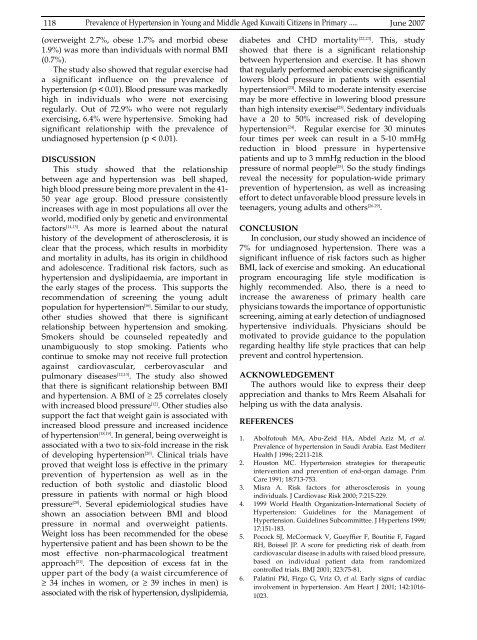Vol 39 # 2 June 2007 - Kma.org.kw
Vol 39 # 2 June 2007 - Kma.org.kw
Vol 39 # 2 June 2007 - Kma.org.kw
- No tags were found...
You also want an ePaper? Increase the reach of your titles
YUMPU automatically turns print PDFs into web optimized ePapers that Google loves.
118Prevalence of Hypertension in Young and Middle Aged Kuwaiti Citizens in Primary ..... <strong>June</strong> <strong>2007</strong>(overweight 2.7%, obese 1.7% and morbid obese1.9%) was more than individuals with normal BMI(0.7%).The study also showed that regular exercise hada significant influence on the prevalence ofhypertension (p < 0.01). Blood pre s s u re was markedlyhigh in individuals who were not exerc i s i n gregularly. Out of 72.9% who were not regularlyexercising, 6.4% were hypertensive. Smoking hadsignificant relationship with the prevalence ofundiagnosed hypertension (p < 0.01).DISCUSSIONThis study showed that the re l a t i o n s h i pbetween age and hypertension was bell shaped,high blood pressure being more prevalent in the 41-50 year age group. Blood pressure consistentlyincreases with age in most populations all over theworld, modified only by genetic and environmentalfactors [14,15] . As more is learned about the naturalhistory of the development of atherosclerosis, it isclear that the process, which results in morbidityand mortality in adults, has its origin in childhoodand adolescence. Traditional risk factors, such ashypertension and dyslipidaemia, are important inthe early stages of the process. This supports therecommendation of screening the young adultpopulation for hypertension [16] . Similar to our study,other studies showed that there is significantrelationship between hypertension and smoking.Smokers should be counseled repeatedly andunambiguously to stop smoking. Patients whocontinue to smoke may not receive full protectionagainst card i o v a s c u l a r, cerberovascular andpulmonary diseases [12,13] . The study also showedthat there is significant relationship between BMIand hypertension. A BMI of ≥ 25 correlates closelywith increased blood pressure [12] . Other studies alsosupport the fact that weight gain is associated withincreased blood pressure and increased incidenceof hypertension [18,19] . In general, being overweight isassociated with a two to six-fold increase in the riskof developing hypertension [20] . Clinical trials haveproved that weight loss is effective in the primaryp revention of hypertension as well as in thereduction of both systolic and diastolic bloodpressure in patients with normal or high bloodpressure [20] . Several epidemiological studies haveshown an association between BMI and bloodp re s s u re in normal and overweight patients.Weight loss has been recommended for the obesehypertensive patient and has been shown to be themost effective non-pharmacological tre a t m e n tapproach [21] . The deposition of excess fat in theupper part of the body (a waist circ u m f e rence of≥ 34 inches in women, or ≥ <strong>39</strong> inches in men) isassociated with the risk of hypertension, dyslipidemia,diabetes and CHD mortality [ 2 2 , 2 3 ] . This, studyshowed that there is a significant re l a t i o n s h i pbetween hypertension and exercise. It has shownthat regularly performed aerobic exercise significantlylowers blood pressure in patients with essentialhypertension [23] . Mild to moderate intensity exercisemay be more effective in lowering blood pressurethan high intensity exerc i s e [ 2 3 ] . Sedentary individualshave a 20 to 50% increased risk of developinghypertension [24] . Regular exercise for 30 minutesfour times per week can result in a 5-10 mmHgreduction in blood pre s s u re in hypertensivepatients and up to 3 mmHg reduction in the bloodpressure of normal people [25] . So the study findingsreveal the necessity for population-wide primaryprevention of hypertension, as well as increasingeffort to detect unfavorable blood pressure levels inteenagers, young adults and others [26-29] .CONCLUSIONIn conclusion, our study showed an incidence of7% for undiagnosed hypertension. There was asignificant influence of risk factors such as higherBMI, lack of exercise and smoking. An educationalp rogram encouraging life style modification ishighly recommended. Also, there is a need toi n c rease the awareness of primary health carephysicians towards the importance of opportunisticscreening, aiming at early detection of undiagnosedhypertensive individuals. Physicians should bemotivated to provide guidance to the populationregarding healthy life style practices that can helpprevent and control hypertension.ACKNOWLEDGEMENTThe authors would like to express their deepappreciation and thanks to Mrs Reem Alsahali forhelping us with the data analysis.REFERENCES1. Abolfotouh MA, Abu-Zeid HA, Abdel Aziz M, et al.Prevalence of hypertension in Saudi Arabia. East MediterrHealth J 1996; 2:211-218.2. Houston MC. Hypertension strategies for therapeuticintervention and prevention of end-<strong>org</strong>an damage. PrimCare 1991; 18:713-753.3. Misra A. Risk factors for athero s c l e rosis in youngindividuals. J Cardiovasc Risk 2000; 7:215-229.4. 1999 World Health Organization-International Society ofHypertension: Guidelines for the Management ofHypertension. Guidelines Subcommittee. J Hypertens 1999;17:151-183.5. Pocock SJ, McCormack V, Gueyffier F, Boutitie F, FagardRH, Boissel JP. A score for predicting risk of death fromcardiovascular disease in adults with raised blood pressure,based on individual patient data from randomizedcontrolled trials. BMJ 2001; 323:75-81.6. Palatini Pkl, Firgo G, Vriz O, et al. Early signs of cardiacinvolvement in hypertension. Am Heart J 2001; 142:1016-1023.
















